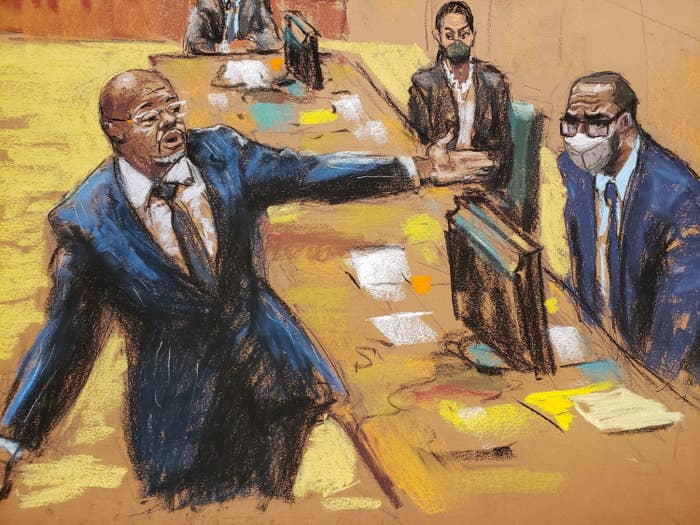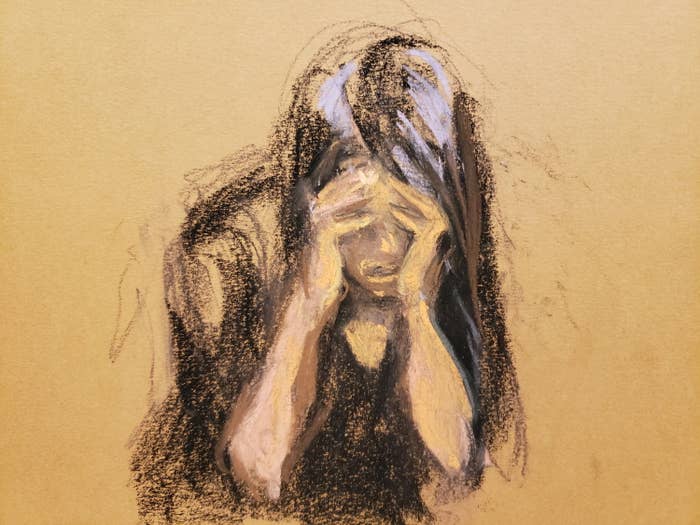
BROOKLYN — R. Kelly’s defense lawyer gave his closing argument in the singer’s federal trial on Thursday, accusing the many alleged victims of lying and comparing Kelly to Martin Luther King Jr., Hugh Hefner, and Mike Pence.
Attorney Deveraux Cannick’s MLK metaphor, which he opened his argument with, was convoluted, and it was not clear what similarities he was trying to draw between the civil rights leader and Kelly, who is facing charges of racketeering and human trafficking.
Kelly’s proclivity for younger women — who, in some cases, were actually teenage girls — was described by Cannick as nothing more than a “May-to-October relationship,” an apparent muddling of the term “May-to-December romance.”
“Older man, somewhat younger women ... some people just like it that way,” he said.
He also described Kelly’s lifestyle as that of a “playboy” and “sex symbol.”
“Hugh Hefner — that was his life,” Cannick said. “Not a crime.”
Kelly has been accused of controlling his alleged victims with strict rules, including that they had to call him “daddy.” Cannick criticized this point, calling it “almost a crime to call a man ‘daddy’” and saying it is a normal thing to call someone in “certain cultures, [like] ‘papi.’”
He added, “The former vice president Mike Pence calls his wife ‘mother.’”
What was clear was Cannick’s strategy for having his client acquitted: asserting that the more than 40 witnesses called by prosecutors — who had described, at times in graphic detail, the alleged abuse — were lying. He characterized minor discrepancies or uncertainties as smoking guns, obfuscated details from testimony, and slammed numerous alleged victims as liars out for financial gain, even calling one — who had testified that she was 16 when she first had sexual contact with Kelly — a “stalker” and “groupie extraordinaire.”
“Some of the witnesses, just lie after lie after lie ... and the government let them lie,” Cannick said.
The government’s rebuttal, delivered by Assistant US Attorney Nadia Shihata, encouraged the jury to focus on the hundreds of pieces of evidence that have been presented in the trial: DNA, travel records, text messages, handwritten letters, photos, Facebook screenshots, audio and video recordings, the sworn testimony of dozens of witnesses, and more.
“You can convict the defendant based on the witness testimony alone,” Shihata said, “but there is so much more than that.”
Cannick largely did not acknowledge the government’s roughly six-hour-long closing argument, instead focusing on minor details of which witnesses had been uncertain to suggest their stories didn’t add up, while simultaneously inserting his own discrepancies; at one point, he sneered at the supposed allegation that Kelly had kept women in “cages,” but never during the trial did anyone accuse him of doing that. (Following an objection from the prosecution, Cannick said that any erroneous information he put forth was due to a “faulty memory” and “not with intent to deceive.”)
Shihata lambasted Cannick’s tactics in her rebuttal, saying much of what he had said was “not in the record and is not true.”
“Don’t let them gaslight you,” she said.
She also criticized how the defense had blamed witnesses for their own alleged abuse. Cannick has repeatedly questioned why they didn’t leave Kelly sooner or call the police, despite a forensic psychologist’s testimony on how often victims of abuse go back to their abuser and stay silent.
“It’s like we took a time machine and went back to a courthouse in the 1950s,” Shihata said. “What they’re arguing is that all of these women and girls were asking for it, and they deserved what they got — never mind that many of them were teenagers, too young to consent.”

During his closing argument, Cannick repeatedly mocked Kelly’s alleged victims and accused them of lying about being sexually abused. He attempted to cast doubt on the testimony given by Sonja — who had testified that Kelly once held her in a room for days, depriving her of food and water before drugging and raping her — by questioning why she didn’t leave when an employee offered her a condom, why she didn’t go to the police, and why she put on her nightgown if she wanted to escape. He even mimicked her, at one point saying in a small voice through fake tears, “He raped me.” To explain how Jerhonda Pace — who testified that she first had sexual contact with Kelly at 16 — wound up with a shirt covered in semen matching his DNA, Cannick offered a conspiracy theory, saying she had someone “jump over the fence” to break into Kelly’s home and steal it.
Throughout the trial and again on Thursday, Cannick stressed Kelly’s supposed generosity as proof of his innocence — the fact that he took his girlfriends shopping, paid for their Ubers, and threw them birthday parties. It was the loss of this glamorous “lifestyle,” Cannick suggested, that led to the alleged victims attempting to “monetize” their stories through lawsuits and appearing in the docuseries Surviving R. Kelly.
“A lot of people were watching Surviving R. Kelly,” Cannick said, “and now a lot of people are surviving off R. Kelly.”

